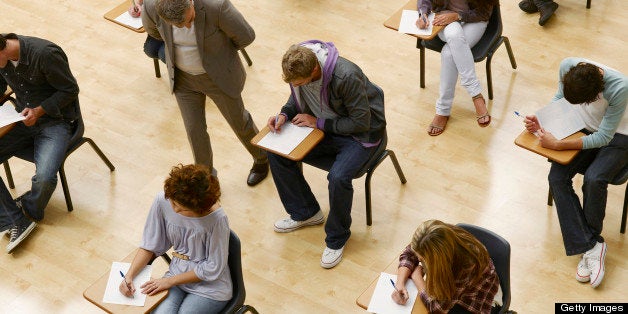
The U.S. Department of Education, Congress, the last two presidents, and textbook and test publishing companies are in love with high-stakes multiple-choice standardized tests. In the name of higher standards, teaching and learning have been pushed aside as students face test after mandated test. A new report from FairTest (National Center for Fair and Open Testing), Assessment Matters: Constructing Model State Systems to Replace Testing Overkill, charges that the "test-and-punish approach" embodied in federal legislation from No Child Left Behind through Race to the Top and the Every Student Succeeds Act (ESSA) has "undermined educational quality for many and inhibited school improvement," especially in the most "under-resourced communities." It has produced "mass firings, school closings, and deteriorating educational climates that fed the school-to-prison pipeline."
The power of the FairTest report lies in its acknowledgement of the value of assessing student work, coupled with descriptions of what fair and useful assessment actually looks like in schools. The report describes a "model system that could be built under ESSA." They believe their approach will "liberate classroom assessment from the confines of standardized tests, as well as provide useful accountability data."
The core of the FairTest approach to assessment is the evaluation of classroom-based evidence of student learning. It can include "student work gathered and evaluated in portfolios, learning records, work samples, or performance tasks produced as part of ongoing academic activities. It can incorporate student work done out of school, such as internships, and can include group projects." This approach emphasizes "practitioner-designed and student-focused assessments that emerge from ongoing schoolwork."
According to FairTest, "High-quality assessment is necessary for ensuring a strong and vibrant education for all. But it is not sufficient . . . In schools dominated by standardized testing, teaching, learning and a healthy climate are endangered. Schools that serve primarily low-income students, black and brown youth and recent immigrants, as well as those with disabilities, most need a major infusion of resources and high-quality assessment. By improving student assessment and school evaluation, the nation can help ensure that schools meet the needs of every child. Without those changes, they will continue to be pressured to focus on a narrow conception of human potential."
The report highlights New Hampshire's Performance Assessments for Competency Education (PACE) system as an assessment model that can be adopted on a much broader scale. PACE combines limited state testing with teacher-made Common Tasks. This assessment system includes "teachers evaluating each student based on local tasks and a complete review of the student's work throughout the year." New Hampshire has also been careful compare student scores on state tests and Tasks to ensure assignments are comparable and assessments are valid. The teaching and assessment process used in New Hampshire builds on models originally developed in Australia and Great Britain.
New Hampshire is now entering its third year using the Performance Assessment for Competency Education (PACE). The FairTest report also looks at other successful performance assessment programs. They include New York's Performance Standards Consortium, the Learning Record developed in Great Britain, the Work Sampling System developed by Samuel Meisels at the University of Michigan, Big Picture Learning, which is now used in over 65 schools nationwide, and the International Baccalaureate program. Performance tasks take various forms ranging from short pieces of work to extended projects, and often include group tasks.
In New York City, Consortium schools have been using alternative assessment approaches since 1997. Consortium schools require that students complete academic tasks to demonstrate college and career readiness and to qualify for graduation. Task topics emerge from class readings and discussion. Sometimes they are designed by a teacher and at other times by students themselves. To maintain standards and consistency graduation level tasks are evaluated using Consortium rubrics. According to a Consortium report, a typical social studies task "requires students to develop a text-based research and analytical paper in history or the social sciences. The paper consists of an argument organized around an idea, thesis or question and is supported by accurate and persuasive evidence from both primary and secondary sources. Alternative points of view are presented, explained, and analyzed. In addition to demonstrating accepted conventions of standard English, the paper is also expected to show evidence of a student's voice and writing style."
Results bear out the Consortium approach. The graduation rate for students attending Consortium schools is higher than the overall graduation rate for New York City public schools and many graduates perform well in college, often at prestigious universities. These achievements occurred despite the fact that students attending Consortium schools were more frequently living in poverty, were more often English Language learners, and started with lower average English and math skills, than other students in the city's public high school system.
High-stakes test advocates claim their approach to teaching and learning is data driven. But the evidence is in. Assessing doesn't mean testing.
Follow Alan Singer on Twitter: https://twitter.com/ReecesPieces8
